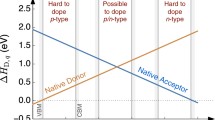Abstract
We have developed a hybrid method that can be applied to study isolated defects in semiconductor compounds and superlattices. The method is a combination of (1) a long-range tight-binding (TB) Hamiltonian, (2) a first-principles Hamiltonian, and (3) a Green’s function (GF) formalism. The calculation of the GF requires accurate energy band structure, wave functions, and defect potentials. The TB Hamiltonian with sp 3 orbitals basis ensures accurate band gaps and band masses while providing the functional form for the wave functions. We calculated the band gaps of InAs/GaSb and InAs/InAsSb strained-layer superlattices and found them to agree well with measurements. The change in potentials caused by native point defects (NPDs) was obtained from a first-principles method using Spanish Initiative for Electronic Simulations with Thousands of Atoms, which also uses sp 3 basis. We describe the method of calculating NPD energy levels in compounds and superlattices, obtain some defect levels in GaAs, InAs, InSb, and GaSb compounds, and provide details of the NPD-level calculations.
Similar content being viewed by others
References
D.L. Smith and C. Mailhiot, J. Appl. Phys. 62, 2545 (1987).
R.H. Miles, J.N. Schulman, D.H. Chow, and T.C. McGill, Semicond. Sci. Technol. 8, S102 (1993).
R.H. Miles, ONR Rep. 92, 28942 (1992).
C.H. Grein, P.M. Young, and H. Ehrenreich, Appl. Phys. Lett. 61, 2905 (1992).
G. Brown, Proceedings of SPIE 5783 (SPIE, Bellingham, 2005), p. 65.
W. Tennant, The Wonder of Nanotechnology: Quantum Optoelectronic Devices and Applications, ed. M. Razeghi, L. Esaki, and K. von Klitzing (Bellingham: SPIE, 2013),
E. Plis, N. Gautam, S. Myers, S.S. Krishna, E.P. Smith, S. Johnson, and S. Krishna, Proceedings of SPIE, pp. 8012–80120X (2011).
D.Z. Ting, C.J. Hill, A. Soibel, S.A. Keo, M. Mumolo, J. Nguyen, and S.D. Gunapala, Appl. Phys. Lett. 95, 023508 (2009).
J.R. Meyer, C.A. Hoffman, F.L. Bartoli, and L.R. Ram-Mohan, Appl. Phys. Lett. 67, 757 (1995).
E.H. Steenbergen, B.C. Connelly, G.D. Metcalfe, H. Shen, M. Wraback, D. Lubyshev, Y. Qiu, J.M. Fastenau, A.W.K. Liu, S. Elhamri, O.O. Cellek, and Y.-H. Zhang, Appl. Phys. Lett. 99, 251110 (2011).
S.P. Svensson, D. Donetsky, D. Wang, H. Hier, F.J. Crowne, and G. Belenky, J. Cryst. Growth 334, 103 (2011).
J.G. Pellegrino and R. DeWames, Proceedings of SPIE, pp. 7298–72981U (2009).
S.P. Svensson, D. Donetsky, D. Wang, P. Maloney, and G. Belenky, Proceedings of SPIE, pp. 7660–7660 V-1 (2010).
G. Belenky, G. Kipshidze, D. Donetsky, S.P. Svensson, W.L. Sarney, H. Hier, L. Shterengas, D. Wang, and Y. Lin, Proc. SPIE 8012, 80120W (2011).
Y. Chang, C.H. Grein, J. Zhao, C.R. Becker, M.E. Flatte, P.-K. Liao, F. Aqariden, and S. Sivananthan, Appl. Phys. Lett. 93, 192111 (2008).
D. Rhiger, R.E. Kvaas, S.F. Harris, and C.J. Hill, Infrared Phys. Technol. 52, 304 (2009).
L. Colombo, Ann. Rev. Mater. 32, 271 (2002).
Y. Wei and M. Razeghi, Phys. Rev. 69, 085316 (2004).
E.G. Wang and D.S. Wang, J. Phys. 4, 1311 (1992).
M.E. Flatte and C.F. Pryor, Proc. SPIE 7608, 760824 (2010).
V. Virkkala, V. Havu, F. Tuomisto, and M.J. Puska, Phys. Rev. 86, 144101 (2012).
Y.C. Chang, R.B. James, and J.W. Davenport, Phys. Rev. B 73, 035211 (2006).
P.R. Briddon and M.J. Rayson, Phys. Status Solidi (b) 248, 1301 (2011).
M.S. Hybertsen and S.G. Louie, Phys. Rev. B 34, 5390 (1986).
A.D. Becke, J. Chem. Phys. 98, 1372 (1993).
J. Heyd, J.E. Peralta, G.E. Scuseria, and R.L. Martin, J. Chem. Phys. 123, 174101 (2005).
S. Krishnamurthy and M.A. Berding, J. Appl. Phys. 90, 828 (2001).
J.A. Moriarty, Phys. Rev. B 5, 2066 (1972).
S.P. Reifman and B.V. Schulichenko, Phys. Status Solidi (b) 96, 537 (1979).
G.A. Baraff and M. Schulter, Phys. Rev. B. 10, 4965 (1979).
J. Bernholc, N.O. Lipari, and S.T. Pantlides, Phys. Rev. B 21, 3545 (1980).
D. Vanderbilt and J.D. Joannopoulos, Phys. Rev. B 22, 2927 (1980).
D.N. Talwar and C.S. Ting, Phys. Rev. B 25, 2660 (1982).
A.-B. Chen and A. Sher, Semiconductor Alloys (New York: Plenum, 1995).
J.R. Chelikowsky and M.L. Cohen, Phys. Rev. B 14, 556 (1976).
I. Vurgaftman, J.R. Meyer, and L.R. Ram-Mohan, J. Appl. Phys. 89, 5815 (2001).
F. Szmulowicz, H. Haugan, and G.J. Brown, Phys. Rev. B 69, 155321 (2004).
A.P. Ongstad, R. Kaspi, C.E. Moeller, M.L. Tilton, D.M. Gianardi, J.R. Chavez, and G.C. Dente, J. Appl. Phys. 89, 2185 (2001).
R. Kaspi, C. Moeller, A. Ongstad, M.L. Tilton, D. Gianardi, G. Dente, and P. Gopaladasu, Appl. Phys. Lett. 76, 409 (2000).
E.H. Steenbergen, O.O. Cellek, D. Lubyshev, Y. Quiu, J.M. Fastenau, A.W. Liu, and Y.-H. Zhang, Proceedings of SPIE, pp. 8268–82680 K-1 (2012).
N.J. Ekins-Daukes, K. Kawaguchi, and J. Zhang, Cryst. Growth Des. 2, 287 (2002).
J.M. Soler, E. Artacho, J.D. Gale, A. García, J. Junquera, P. Ordejon, and D. Sanchez-Portal, J. Phys 14, 2745 (2002).
J. Lagowski, D.G. Lin, T.-P. Chen, M. Skowronski, and H.C. Gatos, Appl. Phys. Lett. 47, 929 (1985).
ACKNOWLEDGEMENTS
The authors thank USAF contract (# FA8650-11-D-5800/TO 0008) through UTC subcontract (# 14-S7408-02-C1) for the funding, and Dr. Gail Brown for critical reading of the manuscript.
Author information
Authors and Affiliations
Corresponding author
Rights and permissions
About this article
Cite this article
Krishnamurthy, S., Van Orden, D. & Yu, ZG. Hybrid Hamiltonian and Green's Function Approach for Studying Native Point Defect Levels in Semiconductor Compounds and Superlattices. J. Electron. Mater. 45, 4574–4579 (2016). https://doi.org/10.1007/s11664-016-4494-5
Received:
Accepted:
Published:
Issue Date:
DOI: https://doi.org/10.1007/s11664-016-4494-5




